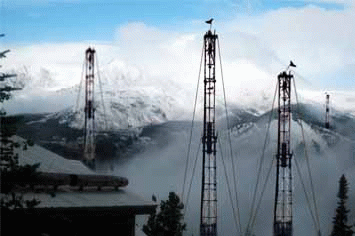This article emerged
from the sixth of nine planned lectures held by the Center of the American
West, CU Continuing Education, Boulder County, and the AirWaterGas Research
Network (of the National Science Foundation/Sustainability Research Network) on
various aspects of hydraulic fracturing.
Frack the Rockies by jdial, photo credit
We were treated to two speakers on the subject of the state of our air. Jana Milford[1], an
engineer and lawyer, began by requesting that we stop her if we heard her use
the words "frack" or "hydraulic fracturing".
She did not explain her reason but one suspects it might stem from their
status as "loaded" words. One avoids provoking
the petulant throng. Of the options for assessing atmospheric impacts of our actions, said NOAA scientist Gabrielle Petron[2], she prefers the evidentiary approach and so spends much time in the field collecting air. What she finds is not always expected.
As of 2012, 26 percent of US power was derived from natural
gas, and that percentage is growing. Colorado
is approaching 50,000 active fracking wells; compare that to the 35,000 populating the
Middle East. Yet among
Wyoming, New Mexico, Utah, and Colorado, the four states straddling our
substrate of fecund shale, Colorado is not foremost in wells. That position is held now by Wyoming, formerly by New Mexico. These are production
trends, Milford tells us, that lead to emissions. But, she hastens to add, fracking is hardly
the sole source of such emissions. Don't
forget feedlots and landfills.
And while the Front Range with its temperature inversions
suffers hot-weather ozone spikes, said Petron, gas fields in Utah and Wyoming measure oddly
high levels of ozone in winter. Also
of interest is that regulators who set monitors to measure air in Denver
and Fort Collins have not seen fit to place any in the multi-poked gas
fields of Weld County.
Natural gas is lighter than air, highly combustible, clean-burning, and odorless; mercaptan with its distinctive smell is added to make even small leaks easy to detect. (It's a pity mercaptan can't be sooner paired.) Although natural gas burns relatively cleanly into carbon dioxide and water, when vented into air intact, its main component, methane, ton for ton traps 25 times more warmth than does carbon dioxide. Opportunities for escape are frequent and far-flung, from well-heads, valves, pipelines, storage tanks, compressors, controllers, connectors, and trucks. Methane leaks are invisible to the naked eye but become startlingly real through an infrared lens:
Infrared methane emissions by Photo credit: US Environmental Protection Agency
Ozone to oxygen
Much like Janus, the ozone that plagues us has two faces. In the high reaches of the stratosphere, ozone forms when ultraviolet rays split
oxygen molecules--O2--into two oxygen atoms, each of which, free and unstable as college
freshmen, quickly collude with intact oxygen to form ozone, O3 (or with another
oxygen atom to re-form O2). During their
short lives ozone molecules protect life below by intercepting ultraviolet rays
much like sunscreen, but they in turn are quickly split again by UV rays into
highly reactive oxygen atoms looking to hook up again. And so it goes.
High in the stratosphere ozone is protective of life, but in
the troposphere where we live it hampers it.
The troposphere,
ranging from sea level to 11 miles high, is too low for ozone to serve as
sunscreen; worse, when inspired it promotes inflammation, asthma, and premature
mortality.
Back in the days of the gold rush that spawned it, mile-high
Denver had no
ozone problem. In the unpolluted
troposphere, ultraviolet
radiation reacts with nitrogen dioxide to form nitrogen oxide and ozone,
which, in turn, quickly reform into nitrogen dioxide. This photochemical cycling is rapid and clean,
producing little or no net ozone.
Oxygen to NOx and VOCs
But soon enough we started burning things in earnest. Nitrogen oxide (or nitric oxide, sometimes regaled
as a performance-enhancing supplement) and nitrogen dioxide are compounds of
nitrogen and oxygen collectively labeled as nitrogen oxides (NOx). Although nature can produce them, humans
crank them out in such high-combustion activities as coal burning, motor
running, and cigarette smoking; the higher the temperature the more you get. Nitrogen
dioxide, one of six criteria
air pollutants defined by EPA[3], imparts the yellow-brown haze that hovers
over cities and abrades the windpipe.
Found in all living things, organic
compounds contain carbon. Volatile organic
compounds (VOCs) are so called
because of their propensity to gasify out of paints, paint strippers, cleaning
supplies, glues and adhesives, permanent markers, fuels, and other unsavories. Methane is a VOC[4].
(Note: You can view every article as one long page if you sign up as an Advocate Member, or higher).







